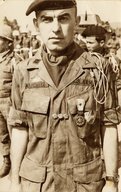
|

|
|
|
|
One of four children, including a twin sister, John was born in Brookings, South Dakota to Jerry Mitchell and Josephine Steward Mitchell, a teacher. His father owned half of a farm and worked as a chemical distributor for Western Chemical. John says families in that area demanded high academic standards. "I'd say 90 percent of my fellow students went on to get a degree," he says. Most of his teachers were wives of men who taught at South Dakota State University in Brookings. In spare time John went pheasant hunting and played sports, including hockey and football. He also worked on the farm and at other after-school jobs as a meat cutter and "carry-out boy in a grocery store". The family attended Thomas Moore Catholic Church. Graduating from Brookings High School in 1958 he entered South Dakota State, where he joined Army ROTC. Although he studied political science, he recalls his real goal was to be a second lieutenant in the army. "I just thought that was the coolest thing in the world," he remembers. He graduated in June of 1962 and was ordered to Fort Knox, Kentucky for an eight-week school in armor. Upon graduating he became commander of a company of cadre that trained AIT (Advanced Individual Training) units. "I was a company commander my first day in the army," he recalls of leading Bravo Company, 1st Battalion School Brigade. Two years later he was assigned as company commander to his first regular army line unit, A Company, 4th Battalion, 37th Brigade. Its mission was to "help secure the gold vault" at Fort Knox. On January 4, 1965 he married Patricia Bumba, a psychiatric nurse from Louisville. (They would have three children and five grandchildren.) He was assigned to 2nd Squadron, 14th Cavalry and sent to Bad Kissingen, Germany, where his squadron was assigned as a border patrol unit in an area between Colberg and Nuremberg. Often, communist forces would muster its tanks along the border. "It was barrel to barrel up there," he says. He recalls that the work was hard and the weather "awful, rainy, damp, cold". After 13 months John began training for duty in Vietnam by completing schools in language, special warfare, and jungle training. He arrived in Pleiku in Vietnam on October 24, 1967 as an adviser to 3rd Battalion, 3rd Regiment. This mechanized infantry battalion included mortars and approximately 24 vehicles, including 17 armored personnel carriers mounted with .50 caliber machine guns. Its task was to guard a road between Pleiku and Kontum. John was then sent to a coastal base, Ben Song, where he worked as a coordinator for fire support, including air strikes and artillery, similar to a forward air controller. On January 14, 1968 he fought a fierce, one-day battle with elements of 24th NVA (North Vietnamese Army) Regiment that, he believes, was moving into position for the Tet Offensive. In this battle of Tam Quan he earned the Bronze Star with V and the Vietnamese Gallantry Gold Cross. His battalion was next sent to guard the perimeter of Phu Kat Air Force Base, located north of Qui Hnon in II Corps in central Vietnam. Near Phu Mie he fought the 2nd Battalion, 18th NVA in a two-day battle. After seven months on line, John was assigned to a staff position in G3 at Pleiku, where he presented reports of operations at morning briefings. He also briefed all incoming officers. He finished his tour in November of 1968 and returned to America, where, he recalls, he experienced no adverse comments from anti-war civilians. The veterans of that conflict, however, were not treated fairly, he says. "The Vietnam vet was hosed. He got a bad deal, and they were fine soldiers," he remarks. John entered United States Infantry School at Fort Benning near Columbus, Georgia. After graduating in 1969 he was assigned as a military historian and ROTC commander at University of Miami, where he completed his master's degree in military history in 1973. He was next assigned as head of the military history department at Fort Knox where he worked for the son of General George S. Patton, Jr., Major General George S. Patton III. "Great guy. He loved history," John recalls. In July of 1975 he was sent to Korea as an inspector general on a 13-month tour. While at Camp Humphreys he taught Civil War history in an educational facility run by University of Maryland. Back in America, he completed the one-year Command and General Staff College in Fort Leavenworth, Kansas, where he made the commandant's list--top ten out of a class of 700. He then spent three years at Fort Stewart near Savannah, Georgia, as executive officer of a tank battalion, 5th of the 37th, and then as an inspector general. He then was sent to the University of Kentucky to command ROTC, where about 30 per cent of the cadets were female. John retired from active duty on 1 January 1983, and became head of ROTC at C.E. Byrd High School in Shreveport. He was in charge of more than 500 cadets and a staff of nine. Meanwhile, a racing enthusiast, he became an inspector of contestant cars at the Indianapolis Speedway, making sure all fit the correct dimensions required. After retiring from Byrd in 2000 he became a tour guide at Barksdale Museum at Barksdale Air Force Base. |


